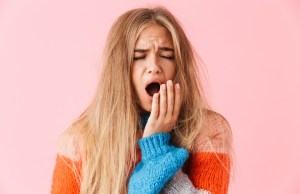Depression and anxiety might be the Ross and Rachel of the mental health field. You try to think of them as separate entities, two platonic Friends with a romantic history, but then they’re back together again. And even in the episodes when they’re not together, you still feel the tension.
Clinically, depressive disorders and anxiety disorders live far apart (or at least in neighboring chapters) in the Diagnostic and Statistical Manual of Mental Disorders (DSM-5), but they often coexist in the real world. International mental health surveys from the World Health Organization (WHO) show that about 46% of people with lifetime major depressive disorder (MDD) also have at least one lifetime anxiety disorder.
This guide will take a deeper look at the intersection of depression and anxiety. We’ll explore how the two mental health conditions overlap, and why they’re so frequently comorbid (occurring at the same time). Finally, we’ll examine the best treatments for each type of disorder. We will also attempt to avoid further Ross and Rachel comparisons so as not to subject you to bad jokes about depression and anxiety being “on a break,” etc. Let’s get started.

What’s the Connection Between Depression and Anxiety?
Depression (aka major depressive disorder, clinical depression, major depression, and unipolar depression) is a mental health disorder characterized by intense, enduring feelings of sadness that impair daily life. Depression affects a person’s mood, which is why it’s classified as a mood disorder (or an affective disorder).
In general, anxiety is a normal emotional response to fear-inducing situations. But an anxiety disorder is characterized by excessive and persistent worries that impair daily life. Anxiety affects a person’s autonomic nervous system, specifically their fight-or-flight response.
Depressive disorders and anxiety disorders often go hand in hand, but that doesn’t mean they always share the same features. Here’s a brief rundown of what they have in common, as well as how they differ.
What Depression and Anxiety Have in Common
- They’re both internalizing disorders. People who suffer from depression and/or anxiety generally keep their emotions to themselves rather than manifesting their thoughts and feelings on the outside (externalizing).
- They can both impact functioning. Depression and anxiety can wreak havoc on someone’s personal and professional life, and they cause significant emotional distress.
- They can both lead to avoidance behaviors. For example, someone with anxiety might be reluctant to leave home out of fear of something terrible happening. Someone with depression might stay at home because they lack energy/motivation or they assume no one will like them.
- They share some treatment recommendations. Anxiety and depression respond to many of the same interventions, such as cognitive behavioral therapy (CBT), mindfulness, and physical exercise.
- The worry and sadness seem out of control. Depression and anxiety can both feel overwhelming and unmanageable.
- They can seem inexplicable. Someone with depression can’t always identify a cause for why they suddenly feel despondent, just as someone with panic disorder (a type of anxiety disorder) can’t always explain why they had a panic attack.
- They can share a personality profile. Depressive disorders and anxiety disorders are both associated with the “big five” personality trait of neuroticism.
- They can both affect cognition. Both depression and anxiety can harm memory and executive functioning.
- They can both have physical symptoms. Depression and anxiety may impair sleeping habits, appetite, digestion, energy levels, and much more.
- They can both be side effects. Certain medications and health problems can induce feelings of depression or anxiety, so these potential causes should be ruled out when starting mental health treatment.
How Depression and Anxiety Differ
- “Anxiety” is not technically considered a mental illness, though it can be very serious. Anxiety can be nonpathological (healthy) – an adaptive response to frightening circumstances. Anxiety disorders and major depressive disorder (MDD), however, are considered mental illnesses.
- Suicide risk is greater with depression. People with depression are more likely to consider hurting themselves than people with anxiety.
- Ruminations tend to vary in their content. The thoughts and feelings that anchor both mental health conditions may overlap at times, but for the most part anxiety involves fear, and depression involves sadness, emptiness, guilt, self-loathing, and related emotions/cognitions.
Can I Have Both Depression and Anxiety?
It’s very common to have both depression and anxiety. One highly respected study (the Sequenced Treatment Alternatives to Relieve Depression or STAR*D study) showed that 53% of people with MDD had “significant anxiety.” Let’s take a look at some additional data on depression/anxiety comorbidity.
- Social anxiety disorder: 20-70% lifetime comorbidity with depression (MDD)
- Panic disorder: 50% lifetime comorbidity with MDD
- Generalized anxiety disorder (GAD): 43% lifetime comorbidity with MDD
What is the relationship between depression and anxiety? Sometimes one condition can seem to trigger the other. For example, a person with severe social anxiety might become lonely due to their avoidance behaviors, then develop depression partly because of that isolation. Or someone with severe depression might become scared that everyone will perceive that they’re a bad person or a burden on others, and become too anxious to engage with the world.
If you seek treatment for anxiety and depression in the United States, a mental health professional may draw a distinction between having an anxiety disorder and having major depressive disorder (MDD) with anxious distress. This is because the American Psychiatric Association (APA) uses anxiety symptoms as a further specifier (a way of narrowing down) for MDD.
In the DSM-5, anxious distress is defined as having at least two of the following symptoms for the bulk of a depressive episode:
- Feeling keyed up or tense.
- Feeling unusually restless.
- Difficulty concentrating because of worry.
- Fear that something awful may happen.
- Feeling that the individual might lose control of himself or herself.
The DSM-5 also categorizes anxious distress by severity, based on the above symptoms:
- 2 symptoms = mild
- 3 symptoms = moderate
- 4 or 5 symptoms = moderate-severe
- 4 or 5 symptoms with motor agitation = severe
Unfortunately, prominent anxiety in depressive episodes is associated with lower recovery rates. And in general, people with co-occuring depression and anxiety can be more difficult to treat than people with one or the other condition. It’s important to find a mental health professional who can help you unravel the complexity of your experience.
Symptoms of Depression and Anxiety
Symptoms of depression and anxiety disorders can both include the following:
- Functional impairments
- Clinically significant distress
- Restlessness or psychomotor agitation
- Sleep difficulties
- Physical aches or soreness
- Irritability
- Impaired concentration
- Unusual fatigue
Signs of an anxiety disorder can include a racing heart and/or racing thoughts, nausea, having a sense of impending danger or doom, sweating, dizziness, hyperventilation, headaches, feeling tense or on-edge, and full-blown panic attacks.
Depression symptoms can include suicidal thoughts, appetite changes leading to weight loss or gain, feelings of worthlessness or profound guilt, loss of interest or pleasure (anhedonia) in things or activities someone used to enjoy, and — of course – a depressed mood (feeling sad). If someone doesn’t meet all the criteria for a major depressive episode, they may have minor depression, dysphoria, existential depression, an adjustment disorder with depressed mood (caused by a psychosocial stressor), or another differential diagnosis.
Depression symptoms and anxiety symptoms can also be differentiated by age of onset (AOO). About 70% of people with life-long comorbid MDD and anxiety disorders report that their anxiety symptoms came before their depression symptoms. And a recent large-scale analysis also showed that anxiety disorders tend to have an earlier AOO.
Anxiety and Depression in Children
Children are vulnerable to mental health issues as well, even those we often think of as adult disorders. Depression in children might manifest as irritability, anger, weight issues, or separation anxiety (clinginess to attachment figures). Until the age of 12, children can also be diagnosed with another depressive disorder called disruptive mood dysregulation disorder (DMDD), which is characterized by behavioral issues and persistent irritability. This disorder can morph into depression or anxiety disorders as children mature.
Anxiety in children might manifest as excessive worry about schoolwork, overwhelming fear about something terrible happening to an attachment figure, or extreme phobias. Parents may need to enlist a mental health professional who specializes in child psychology to determine whether those fears go beyond what’s developmentally normal. Studies indicate that specific phobias, separation anxiety, and social anxiety tend to show up in children before mood disorders.
What Is the Root Cause of Depression and Anxiety?
Depression and anxiety are both public health issues that we learn more about every day. Though there are still some unknowns, mental health experts attribute depressive disorders and anxiety disorders to a variety of causes:
Environmental factors: Childhood trauma, abuse, and chronic psychosocial stress tend to increase someone’s risk of developing mental health conditions. The Covid-19 pandemic was responsible for increasing depression and anxiety rates worldwide.
Genetic and biological factors: Family history, individual temperament (which has a strong genetic basis), and biological/neurochemical abnormalities have all been implicated in both depression and anxiety.
Other medical conditions, medications, and mental disorders: Sometimes depression and anxiety can be induced by substance abuse, certain prescription drugs, chronic pain or illness, attention deficit/hyperactivity disorder (ADHD), and health conditions such as heart disease and cancer. These mental health symptoms could indicate the need for primary health care.
How to Cope with Having Both Depression and Anxiety
On their own, both depression and anxiety can cause considerable damage to a person’s life and psyche. Together, they’re even harder to manage. How to deal with anxiety and depression at the same time? First, mental health experts know a lot about what doesn’t work:
- Addictive behaviors (alcohol and drug abuse, promiscuous sex, gambling, overspending)
- Escapist behaviors (total retreat into work or a video game fantasy life)
- Avoidant behaviors (social isolation)
- Self-harm
Though any of these unhealthy coping behaviors might give someone temporary relief from their emotional distress, they will only make depression and anxiety worse in the long term.
Healthy coping usually begins with facing your pain, not avoiding it. It’s common to have both depression and anxiety. You can learn to regulate these feelings through self-compassion and self-care. In time, with the right coping skills, these conditions can become your teachers instead of your enemies.
We acknowledge that’s easier said than done, which is why it helps to have a mental health professional like a counselor or therapist at your side during the process. A therapist can help you see your blind spots and give you the psychological training you need to understand and regulate painful feelings.
People with comorbid anxiety and depression might benefit from any of the following coping strategies:
- Sticking to exercise and sleep routines
- Finding social support/asking for help
- Practicing mindfulness
- Hacking brooding rumination
- Eating well (nourishing food can enhance mental health)
- Accepting yourself
- Feeling compassion for what you’re going through
- Keeping a depression and anxiety journal
- Improving your negative thoughts
- Practicing yoga or meditation
What Are the Best Depression and Anxiety Treatments?
Mental health professionals often operate under the principle that you treat the most impairing condition first. So if you seek treatment for depression and anxiety together, a great therapist will want to devote enough time to exploring your complex symptoms, identifying root causes, and coming up with the best treatment plan.
Therapy for Depression and Anxiety
Depression and anxiety can both be treated with psychotherapy (talk therapy). One of the best treatments for depressive disorders and anxiety disorders is cognitive behavioral therapy (CBT). CBT helps people identify faulty thinking patterns and information processing errors that can drive their maladaptive (unhealthy) behaviors and emotions. This type of therapy is extraordinarily effective in treating depression and anxious thoughts. Some CBT interventions can tackle both depression and anxiety (problem-solving, cognitive restructuring), while others might just target depression (behavioral activation) or anxiety (exposure, relaxation).
People with anxiety and depression may also benefit from dialectical behavior therapy (DBT), acceptance and commitment therapy (ACT), psychoanalysis, problem-solving therapy, and interpersonal therapy.
Medication for Anxiety and Depression
People with depression and/or anxiety can often be effectively treated with selective serotonin reuptake inhibitors (SSRIs), a type of antidepressant. Other medications, such as serotonin-norephinephrine reuptake inhibitors (SNRIs), tricyclic antidepressants (TCAs), and monoamine oxidase inhibitors (MAOIs) can also be prescribed for anxiety and depression. Further research is being conducted to determine if psychedelic substances could help treat both disorders.













